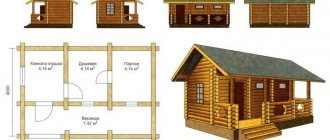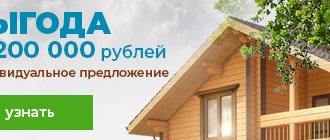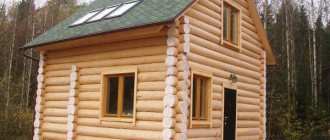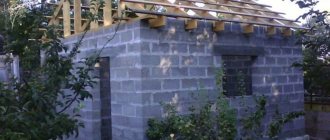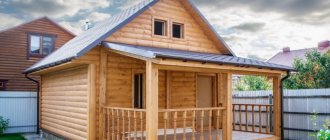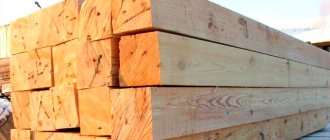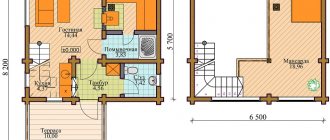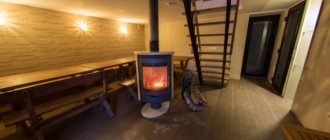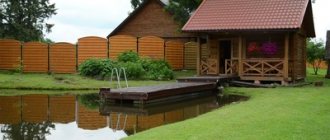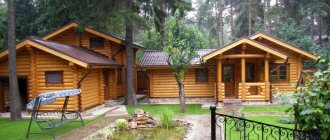The construction of bathhouses from logs is an ancient tradition of our country, which has not lost its relevance in our time. Moreover, with the development of woodworking technologies, building a wooden bathhouse has become easier and faster, and the possibilities for realizing various architectural fantasies have seriously increased.
The group offers bathhouses made of rounded logs - modern lumber, which gives the structure a neat, beautiful appearance, improves the performance properties and service life of the bathhouse. Affordable prices, high quality materials from our own production and professional construction teams are what sets us apart from our competitors.
Only here you will find:
- Detailed projects.
Projects for bathhouses and log houses from “Royal Cedar” contain documents that allow you to save: cutting maps for wall materials (cedar, pine, larch) and specifications for all lumber. Cutting cards mean a 15% saving in logs, assembly according to masonry plans means a 20% reduction in construction time.
- Affordable prices.
We are manufacturers and do not work with intermediaries. Therefore, you can buy a log bathhouse from us at a price from the manufacturer. Customers pay only for the material and the work of our craftsmen; wages for intermediaries and resellers are not included in the construction budget!
- Transparent estimates.
We prepare detailed estimates based on data from the project: cutting maps and specifications. The estimate shows how much the entire log bathhouse costs. How many cubes of logs of the selected diameter are needed for construction? How much lumber and antiseptic will be required? You will see the answers to these questions in our estimate.
- Exclusivity.
It is not so easy to build a log bathhouse with an attic and a veranda from large-diameter logs. Only real master carpenters can work with large round timber. These are the specialists who work for us. We built the first calibrated log house of a cedar bath with a diameter of 500 mm in 2002.
The number of our clients is constantly growing, which eloquently indicates that our bathhouses and log cabins are good not only at the very beginning, but also during operation. Over the years of the company's activity, we have built more than 200 hand-cut bathhouses in Russia and abroad.
Placement of a bathhouse on the site
The first thing one starts from when building a bathhouse from a log is projects, a photo of a sample. But this is not the last thing; to this it is worth adding such an important point as the choice of location. The choice of location for construction depends on a number of factors:
- Building codes (SNiP), which take into account underground communications, distances between buildings, and proximity to neighboring areas.
Even owners should not neglect the rules of SNiP. If the area is encumbered, repair work may be necessary. Incorrect location of the building may also be a reason for neighbors to go to court. Source haatka.ru
- Terrain. Factors such as the proximity of a body of water are taken into account—it is not recommended to place a bathhouse too close to it: the shortest distance is 5 m.
- Proximity of other buildings. The bathhouse is considered an object of increased fire safety, so it should be erected at a distance of 8 m from other structures.
- Zoning of the site. Many people prefer to place bathhouses in the recreation area - a pleasant, cozy corner.
For the construction of a log bath house (projects and prices can be found on our website), the requirements will be more complex, since the construction of residential buildings is regulated by additional legislation.
Layout of buildings on a plot of 15 acres Source pravo.org.ru
Which tree to choose for a log house?
- If you want to order a top-class log bathhouse, pay attention to cedar. It's expensive wood, but you'll never regret building a cedar sauna. It will serve you for a very long time, its walls practically do not crack. The atmosphere and aroma inside the bathhouse will be unforgettable; the healing properties of cedar have no equal. Cedar phytoncides destroy pathogens and become a catalyst for the proliferation of beneficial microorganisms.
- If you want to buy a log bathhouse, the price of which is less than that of cedar, pay attention to pine. A log cabin made of pine is cheaper than cedar and larch log houses, and the performance parameters of this wood are no worse.
- The hand-cut log house made of larch has an unusual exterior and original interior. This wood has an amazing color, which consists of a dozen different shades. Thanks to the special resin contained in the wood, Siberian larch is not dangerous from contact with moisture. This property is important when the question arises of which log house to choose for a bathhouse.
Advantages and disadvantages
Natural wood has an undeniable, beautiful appearance, guarantees safety and durability. A log bathhouse has the following undeniable advantages :
minimal thermal conductivity - retains heat in the room for a long time, warms up many times faster in winter compared to a brick building;- excellent air circulation - condensation does not accumulate, steam “flows” freely;
- sound insulation – absorbs extraneous noise as much as possible, including from the street;
- wood is easy and quick to process - a log house is created in a short time, exclusive options are possible (to order), both in project development and in finishing, carving;
- environmental friendliness, being in a log bathhouse is not only safe, but also useful - pine, cedar and other wood release beneficial essential substances and resins into the air (the steam becomes medicinal);
- affordable price compared to brick construction;
- wear resistance - the structure, if all technological processes during installation are followed, will last for many decades, up to 50 years or more.
a log bathhouse ; additional ventilation is a big savings. Facade cladding and interior finishing are also not required; the log house looks impressive, status-bearing and noble. The variety of different ready-made turnkey projects significantly reduces the construction time of the structure.
But you should not forget about some disadvantages
- a fresh log house needs time to shrink - this period can be shortened by rounded, dried logs;
- wood that is too dry may crack;
- in humid climates, poorly processed logs are susceptible to mold and mildew;
- fire hazard.
If you carry out construction work, following the instructions, taking into account all the features, and choosing the right type of high-quality wood that matches the climate zone, then the log house will last for many decades.
What are the advantages of wooden bathhouses?
People go to the chopped bathhouse not only to perform hygiene procedures. This is a real bath ritual, after which a person feels younger and healthier.
- Special microclimate.
In a log bath, self-regulation of humidity is carried out due to the porous structure of the wood. A custom-made sauna from “Royal Cedar” will be built from selected logs.
- Healing properties.
The air smells of forest, useful phytoncides are in the air. Phytoncides are formed in wood throughout its entire lifespan. This therapy is indicated for people with reduced immunity, suffering from neuroses and headaches of various origins, and hypertensive patients. Log bathhouses are highly valued in Moscow and other large cities, where severe air pollution negatively affects the respiratory system and immunity in general.
- Aesthetics.
The textured pattern of wood is an exclusive decoration that is better than artificial decor. When finishing a log bathhouse with an attic, we recommend replacing covering paints with transparent and tinted impregnations that highlight the wood grain.
Features and characteristics of large diameter logs
For the construction of a bathhouse complex, timber harvested in winter is ideal. Bathhouses are especially beautiful and durable when they are built from large-diameter Arkhangelsk logs. The fact is that in the northern regions the growth period of trees is very short due to the short warm season, which affects the quality of the wood. The annual growth of wood in northern latitudes is, as a rule, several millimeters; for this reason, the wood of trees growing, for example, in the Arkhangelsk region is dense, and this, in turn, affects its quality.
The harsh conditions of northern latitudes lead to extremely slow forest growth; for this reason, the distance between annual rings in such a forest is minimal. The forest of northern latitudes has a high level of strength and resistance to the effects of adverse environmental factors. The building material has a high degree of resistance to the development of decay processes, which is a very important factor in the long-term operation of bath complexes made from such building materials. The use of logs made from trees growing in northern latitudes for the construction of bathhouse complexes makes it possible to extend the service life of bathhouses to 100 years or more.
What are the disadvantages of a round timber bathhouse?
Log houses for baths are characterized by the same disadvantages as other wooden structures. We know about all the features of working with wood and take them into account before building a bathhouse. The price of a log house includes a comprehensive fight against rot, insects and fungi, because these are the main disadvantages of wooden buildings. These are the protection measures we take:
- During transportation, the wall set of the bathhouse and log house is treated with a transport antiseptic. Impregnation of wood with certified antiseptics is carried out during the assembly of the log bathhouse, which allows you to treat all hidden surfaces. It doesn’t matter whether the bathhouse is made of a log house with two floors or one – the protection technology remains the same.
- When finishing walls made of logs, sanding is first done, after which the wooden surfaces are re-antiseptic. Applying the compounds to a sanded log increases the depth of penetration. Beams, sheathing and rafters are impregnated with a primer with an antiseptic component. This is done regardless of the purpose of the building: a bathhouse, a guest log house, a house for permanent residence or a gazebo.
- Re-application of protective compounds on a log bathhouse with a veranda, attic or terrace is carried out in accordance with the manufacturer’s recommendations: from 3 to 5 years, depending on climatic conditions.
- When developing a project for a bathhouse from a log house, constructive protection against rotting is worked out: a bathhouse frame is made with the main roof removed, terraces are created and a high base is designed.
- The first crown of the bathhouse frame is placed on a backing board treated with an antiseptic. Also, for frame crowns, we recommend using moisture-resistant larch, which is not susceptible to rotting.
- Wooden surfaces that come into contact with the heating parts of the stove are finished with non-combustible materials. The places where the sauna stove chimney passes through the wooden floor and roofing system are insulated in accordance with SNIP. A safe and warm turnkey log cabin with a stove is our specialty!
Which is better
I would still like to start by looking at wood. And not immediately by species, but for now only from the popular opinion that the best wood will be that which was harvested in winter.
It is expected that such wood will be drier than wood harvested at other times of the year. But we did a little investigation. In fact, according to wood harvesting reference books, the same conifers contain more moisture in winter than in summer. And it seems to us that the source of this myth was... the birch tree.
All sorts of light walkers and survivalists highly recommend birch as a tree for a winter fire. Because it is much drier than other breeds at this time. And by the way, they really don’t recommend conifers . Their experience also says that this wood is too wet, which means it will burn extremely poorly.
Log houses are also made of birch, of course, but only as part of a bathhouse (steam room). But for the rest, they still prefer spruce and pine (and other conifers) - and not only because they are the most abundant in Russian forests. Therefore, we advise you to be more critical of the myth of “wood harvested in winter.” You should be more interested in humidity and drying conditions .
But it’s better to install a log house in winter . And the reason for this is a fungal disease called “blue” or “blue”. Certain types of fungi change the color of the sapwood to bluish. But the matter is not limited to color - some characteristics of the tree also change, it begins to absorb more moisture, for example. However, strength does not suffer .
So, in winter, mushrooms are much less active , and if they are not encouraged, they will not grow. A log house installed in winter will avoid this disease.
Of course, treatment with an antiseptic and bleach will cause the blue discoloration to disappear. But we are talking about a bath, and the antiseptic is poisonous, so you should not use it in the steam room. Bleach... often it’s just bleach, and it erodes, so you can bleach wood in a steam room, but use it only after the smell disappears (more about bleaching here).
IMPORTANT! Antiseptics must be distinguished for internal and external work, and not be confused with each other. It is worth treating the log after laying it, and with the part that will be inaccessible in the future, do the following - they impregnate not the wood with an antiseptic, but a jute lining (for example).
What species are suitable for logs?
As already mentioned, for the most part these will be coniferous species.
These are the ones you most often find on the market and in the offers of construction companies. Of course, there is a lot of taiga in Russia, but the main reason will still be strength and resistance to rotting thanks to resins . And, of course, the straightness of the trunks is higher for conifers than for deciduous ones. All this applies not only to the cheap pine and spruce mentioned above, but also to more expensive species - larch and cedar. They may also offer you fir.
Among the deciduous trees we would name oak, birch, aspen, alder and linden. But only oak has sufficient strength and resistance to external influences. And it's very expensive.
Since we are talking about a bathhouse, where high temperature softens the coniferous resin and causes it to flow to the surface, there are two options: either partially use hardwood to build a steam room, or line the steam room made of coniferous wood with hardwood paneling .
Spruce has less resin and is lighter in color than pine. Larch and cedar are noble species. Larch is not afraid of water, it only makes it stronger.
BY THE WAY! You shouldn’t delude yourself about cedar - this is not at all the tree from which King Solomon built. Here you will find not Lebanese cedar, but Russian... cedar pine. This is what we call “cedar”.
Whom to choose? Focus on your budget. If it allows, take larch; if not, then pine will do. Although... I would like to advise you not to trust myths too much - under unfavorable conditions, larch may well rot, and under favorable conditions, linden can stand for decades.
And it is worth warning that the rounded log into which cone-shaped trunks turn can, over time, present many unpleasant surprises. Especially from the same larch. If you take an atmospheric drying log, then it often begins to wear out over time. It can curl, bend, or simply go into deep cracks.
This can only be avoided if you take trunks that have been subjected to heat treatment. It comes in two types - regular and chamber. In the first case, uniform shrinkage is achieved, but with preservation of the resin.
The second lasts much longer, and the output is wood with evaporated resin, which does not cause shrinkage, torsional deformation, bending, or cracking . All this is extremely valuable, but the price of such wood is high.
Dimensions, diameter
Before we name the dimensions of a log for a bathhouse, let's briefly go over what we know about trunks. Firstly, they tend to get thinner closer to the crown.
Consequently, the upper diameter will be less than the lower diameter of the cut. And for even laying , a cylindrical rather than a cone-shaped shape is preferable. Therefore, of the three types of processing of trunks - rounding, planing and scraping, we get the maximum level only in the first case, the minimum - in the third, and the second - something in between.
At the same time, rounding is the cheapest , since it is done on machines, while the rest involves manual labor. Manual labor costs more than machine labor. But is a rounded log ideal for use?
There is nothing wrong with the operation itself, and it produces a form that is ideal for construction.
IMPORTANT that the wood itself has no defects and is properly dried. In this case everything will be fine.
The planed version has one caveat: after all, when laying logs in a wall, you should adhere to the GOST rule, according to which 1 cm of camber is allowed for each linear meter. (Let us explain: camber is the change in diameter.)
With the scraped version there is no need to expect compliance with GOST standards for consistency. And all the flaws remain there - changes in thickness are possible in places where branches grow, and the curvature of the trunk is not eliminated.
It is clear that the first and second options are preferable, but not the third.
Now about the uniformity of the logs. There is also a rule about it:
ATTENTION! The permissible difference in the diameters of the crowns used in construction should not exceed 30 mm.
That is, it doesn’t matter whether your diameters are large or small, the main thing is that they are not very different from each other.
Otherwise, the strength of the structure will be in question.
As for the dimensions, the linear dimensions depend on the project and on the climatic conditions of the area where the bathhouse will be located. You should also take into account the seasonality of its use - thinner logs are suitable for a summer bathhouse than for an all-season one.
If the task is to make a very light summer building , you need to take material with a diameter of up to 18 cm . And it is also useful in all-season baths for creating partitions.
A more substantial summer(!) sauna can be made from logs with a diameter of 18-22 cm .
For all-season baths, diameters from 22 to 28 cm . Large numbers are applicable where we are talking about large-area objects or climatic zones with very low temperatures, where logs can be up to 36 cm in diameter (at -45 degrees that’s the best).
How many pieces do you need
There is nothing difficult in the task of calculating how many logs are needed for a bathhouse. Let's describe the solution step by step:
- We look at the plan (about layouts here, if anything) and write down the lengths of all the walls. If you use a smaller diameter for the partition, then count the partitions separately.
- Add up the lengths of the walls. The resulting figure is the total length of one conventional crown.
- Decide what diameter the logs will be.
- The height of the bathhouse is included in the project. Divide the height by the diameter of one crown. The resulting figure is the number of crowns.
- We multiply the length of the conventional crown by the number of crowns. We get the total length of all logs.
- The length of one standard rounded log is 6 meters. We divide the resulting length of all logs by the length of one log. The final figure is the amount of material to be purchased.
- Pediments are considered in a similar way.
Bathhouse made of large and huge logs
We would classify bathhouses made from large and huge logs as design projects. Because there is clearly not so much a construction need as an aesthetic preference . The owner of such a bathhouse clearly likes fabulous, epic times when heroes walked the earth
